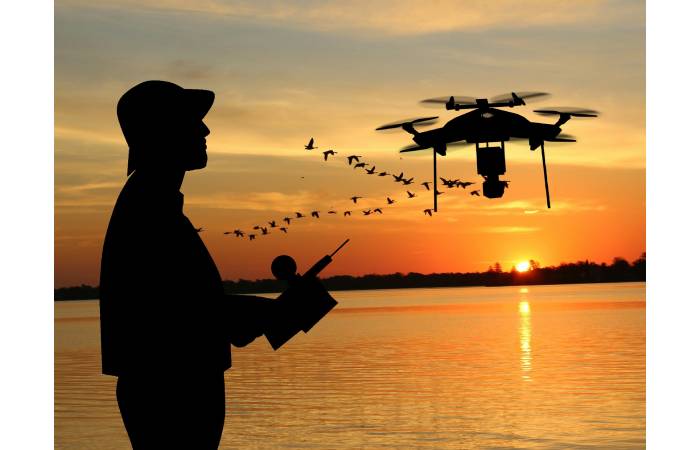Introduction
Drones Racing – FPV drone racing equipped with cameras using head-mounted screens showing live feed. Transmit camera feed from drones. Like full-size air races, the goal is to complete a set course as quickly as possible. racing started in Germany in 2011, with some amateur pilots gathering for semi-organized races. The Drone Racing League (DRL) manufactures all of the drones used in their events at home. Pilots receive drones, backup drones, and parts from the league itself, not independently.
What Are The Drone Racing Technology?
Flying FPV (First Person View) means pilots only see what the drone sees. This is achieving by transmitting live images from a camera mount on the nose of the drone. The idea is transmit via radio (typically 2.4 GHz or 5.8 GHz frequency, 1.3 GHz for remote transmission) to the goggles or monitor worn by the pilot. The remote control, drone, and goggles are all connects by radio and must transmit with sufficient speed and reliability to allow effective management.
While the pilot always requires goggles, some drone racing organizations insist that they should also be worn among spectators by simply changing the frequency to the channel of the racer one wants to watch. Any drone could be use to compete. However, competitive FPV racing leagues require drones to meet specific standards.
Racing drones are built for speed, unlike photo/video drone that focuses more on hovering. 6 A photography quadcopter design typically has four motors configure in an X pattern, all equally spaced. A racing model will typically have all four engines set up in an H pattern to push the drone forward, not up. Another feature specific to drone racing is the number of propeller blades. Propellers with 3 or 4 blades (instead of 2 knives) have a shorter diameter, allowing a more petite frame with more significant acceleration and maneuverability. Due to their lightweight and electric motors with large amounts of torque, drones can accelerate and maneuver with great speed and agility. However, this makes the controls very sensitive and requires a pilot with quick reaction times and a steady hand.
How To Drones Can Operate In Controlling Airspace?

Flying a drone is almost anything but something improvising (unless done in a close space such as a ship or any other type of building). And this is so for many different reasons. The pilot of the DGT, explains that the flights must be very schedule because the space where the drones can fly is increasingly limited. In addition to the fact that there are areas where overflying is prohibite, other areas are restricts, such as airports. “In aeronautical space, not everything goes, and there are areas where flying is easier. and others where coordination with other airspace users is necessary,” explains this pilot. “It is not the same to fly near the head of Barajas, where there are many commercial flights, than to fly in an area where there is nothing.” And coordinating all these aspects “takes a while.” It is very useful device and aircraft.
Which also includes the vicinity of airports. But for each flight, an aeronautical safety study (EAS) must be completed to prevent the risks of said operations. These EAS aims to ensure that there are no collision risks in the drone’s air (Air Risk Collision) with other aircraft.
Which Is Controlling Traffic From Space?
In April of this year, the DGT began to use drones to control the state of traffic. Since this summer, they already have the authority to sanction infractions. The DGT has 21 Phantom M4 and Matrice 200-type aircraft. The former can transmit images in real-time to make decisions (such as adding lanes or cutting them). Matrices can detect breaches. Soon, the DGT will increase its drone fleet by 28 additional units.
These ships are controlling by the 10 DGT pilots and another 20 from the Civil Guard traffic group. Which is in charge of processing the sanctions detects by the Matrice. “Work is a lot of fun. Entertaining and intense. If you like it, it is a privilege to be able to participate in these missions”, says Fernández de Usera. From the headquarters at the Cuatro Vientos airport in Madrid, the pilots attend to the requests of the provincial offices. Pilots and camera operators, loaded with batteries, travel there in official vehicles. To get an idea, the Matrice barely last half an hour, so they take a lot to make several hours of flight.
Spray The Field From The Drone
Another of the industries where the use of drones is being using the most in agriculture. In the field, it is uses to know the health status of the crop or to spray from the drone. The Expert explains that these operations have better results when carry out from the air than with a tractor or other giant machinery. “With a drone, it is the same job. It does not affect contiguous species .”
Professional drone pilots record advertisements and video clips. Still, they fly over our highways to control traffic (and even acceptable violations). Or field areas to adjust irrigation or insecticide application. The State Aviation Safety Agency ( AESA ) has 3,611 drone operators (according to the last update of July 2019). We have spoken with three of them to find out their job, whether it is as simple as carrying a “toy” drone. Or if the experience is more like being an airplane or helicopter pilot.
Conclusion
It is essential that both have many flight hours together to coordinate and understand each other and that it be a fluid job. The dizzying technological development of drones allows these uncrewed aerial vehicles to have an increasing presence. And relevance in audiovisual, messaging, agriculture, firefighting, or surveillance sectors. Its proliferation has also led to the birth of a new sport where skill, speed, model aircraft, and technology are mixed.”


